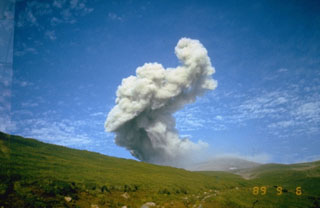Report on Ebeko (Russia) — 7 December-13 December 2016
Smithsonian Institution / US Geological Survey
Weekly Volcanic Activity Report, 7 December-13 December 2016
Managing Editor: Sally Sennert.
Please cite this report as:
Global Volcanism Program, 2016. Report on Ebeko (Russia) (Sennert, S, ed.). Weekly Volcanic Activity Report, 7 December-13 December 2016. Smithsonian Institution and US Geological Survey.
Ebeko
Russia
50.686°N, 156.014°E; summit elev. 1103 m
All times are local (unless otherwise noted)
KVERT reported that, according to observers in Severo-Kurilsk (Paramushir Island) about 7 km E, a gas-and-steam plume containing a small amount of ash rose from Ebeko to an altitude of 1.5 km (4,900 ft) a.s.l., and drifted 6 km N during 8-9 December. The Aviation Color Code was raised to Yellow (the second lowest on a four-color scale). During 9-10 December gas-and-steam plumes with minor amounts of ash rose from two vents, in Sredniy Crater (middle part) and Severny Crater (N part), to altitudes of 1.8-1.9 km (4,900 ft) a.s.l. and drifted 4-5 km NW.
Geological Summary. The flat-topped summit of the central cone of Ebeko volcano, one of the most active in the Kuril Islands, occupies the northern end of Paramushir Island. Three summit craters located along a SSW-NNE line form Ebeko volcano proper, at the northern end of a complex of five volcanic cones. Blocky lava flows extend west from Ebeko and SE from the neighboring Nezametnyi cone. The eastern part of the southern crater contains strong solfataras and a large boiling spring. The central crater is filled by a lake about 20 m deep whose shores are lined with steaming solfataras; the northern crater lies across a narrow, low barrier from the central crater and contains a small, cold crescentic lake. Historical activity, recorded since the late-18th century, has been restricted to small-to-moderate explosive eruptions from the summit craters. Intense fumarolic activity occurs in the summit craters, on the outer flanks of the cone, and in lateral explosion craters.

